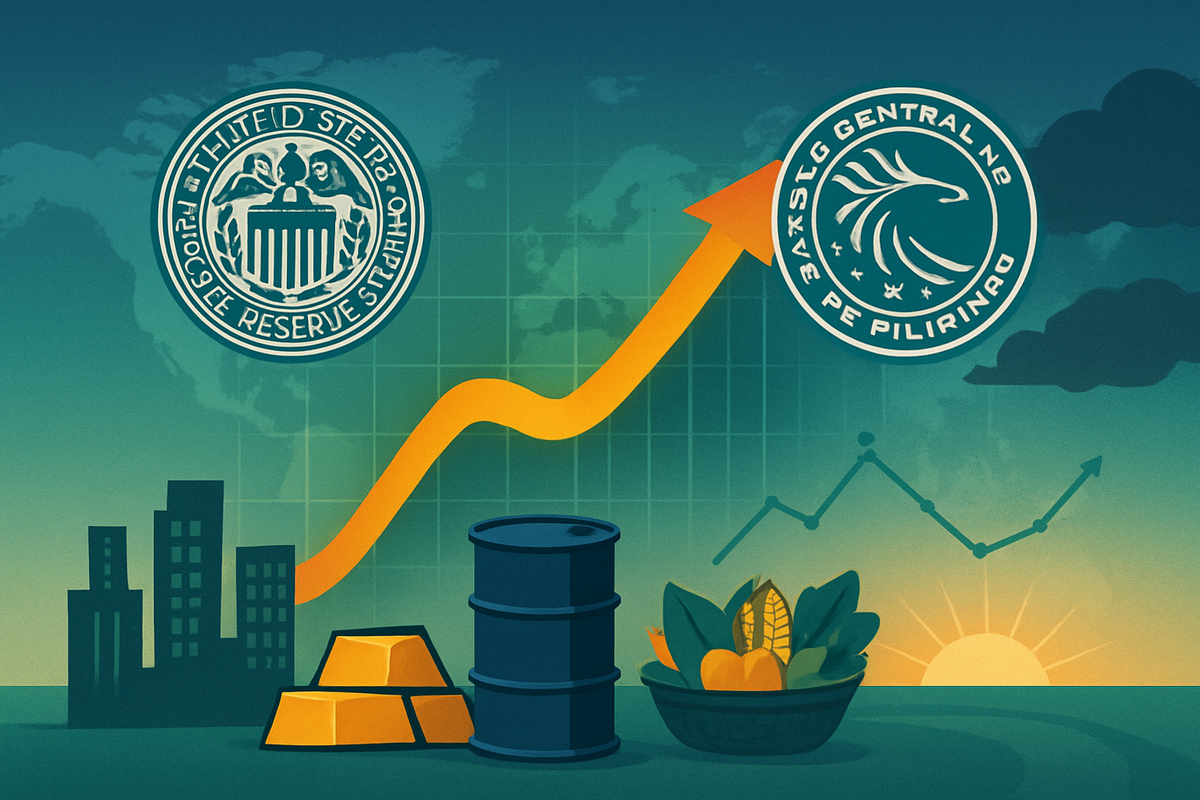
The global financial landscape is currently navigating a pivotal moment, marked by a nuanced and often contradictory inflation narrative. While the U.S. consumer price index (CPI) recorded a 3.0 percent year-on-year rise in September 2025, signaling persistent, albeit moderating, price pressures, other central banks are projecting a more subdued outlook. This mixed bag of data has fueled market speculation, particularly concerning the future trajectory of monetary policy from key institutions like the Federal Reserve, and its profound implications for commodity valuations worldwide.
The slightly lower-than-expected U.S. CPI figure has ignited optimism among investors, bolstering the "soft landing" narrative for the American economy. This scenario suggests that inflation can be tamed without triggering a significant recession, thereby keeping the Federal Reserve on track for anticipated interest rate cuts. Such a shift in monetary policy, moving towards easing, is expected to have immediate ripple effects across global markets, potentially influencing everything from equity performance to the intricate pricing mechanisms of essential commodities.
Central Banks Charting Diverse Courses Amidst Evolving Price Dynamics
The detailed picture of global inflation reveals a divergence in both data and central bank responses. In the United States, the 3.0 percent year-on-year CPI increase in September 2025, driven primarily by gasoline, food, and shelter costs, was nonetheless perceived as a positive sign, coming in slightly below economists' forecasts. This moderation, even with core inflation holding steady, has solidified expectations for the Federal Reserve to continue its easing cycle, following a quarter-point cut in September. Analysts now widely anticipate another 25-basis-point reduction at the upcoming October Federal Open Market Committee (FOMC) meeting, with further cuts projected into early 2026, as the Fed balances inflation control with support for a potentially weakening labor market.
In stark contrast, the Bangko Sentral ng Pilipinas (BSP) maintains a decidedly more sanguine perspective, expecting inflation in the Philippines to be "benign" for the entirety of 2025. With headline inflation in July slowing to a near six-year low of 0.9 percent and averaging 1.7 percent for the first nine months of the year—well within the BSP's 2-4 percent target—the central bank has already implemented two policy rate cuts. Further easing, potentially bringing policy rates to 4.5 percent by year-end and more reductions in 2026, is widely anticipated, reflecting a robustly disinflationary environment in the archipelago. The BSP projects inflation to remain within target, averaging 1.7% for 2025 and rising slightly to 3.3% in 2026 and 3.4% in 2027.
Adding another layer of analytical depth, Keith Rankin's insights into New Zealand's CPI inflation underscore the importance of distinguishing between lagging and leading indicators. Rankin argues that the CPI often lags behind actual price changes, with the Producers Price Index (PPI) offering a more timely gauge of inflationary turning points. His analysis differentiates between "tradable" inflation, influenced by global goods prices, and "non-tradable" inflation, driven by domestic services and construction. Rankin contends that New Zealand's "cost-of-living crisis" stems from "counterproductively high interest rates" that have sustained high non-tradable CPI inflation into 2025, rather than mere inflationary momentum. He forecasts significant falls in PPI-inflation later in 2026, with CPI-inflation to follow in early 2027, highlighting the delayed impact of monetary policy. This perspective suggests that aggressive anti-inflationary policies in late 2023 were potentially unwarranted, as disinflation was already underway.
The immediate market reaction to the slightly softer U.S. CPI data has been overwhelmingly positive. U.S. stock futures surged, and major indices reached new record highs, reflecting strong market confidence in a continued disinflationary trend and further Fed easing. This sentiment, however, is tempered by ongoing concerns about global trade uncertainties, persistent core inflation in some advanced economies like Japan and the UK (where it remains above 3% and closer to 4% respectively), and the potential for an "AI bubble." The recent U.S. government shutdown has also complicated economic data releases, increasing reliance on private sector indicators.
Corporate Fortunes Diverge: Winners and Losers in a Disinflationary Environment
The evolving global inflation landscape, characterized by moderating price increases in key economies and anticipated monetary easing, is poised to reshuffle corporate fortunes, creating distinct winners and losers across various sectors. Companies with strong ties to interest rates and consumer discretionary spending are likely to thrive, while certain commodity producers and traditional banking models may face headwinds.
A primary beneficiary of the anticipated Federal Reserve rate cuts and generally lower borrowing costs will be interest-rate sensitive sectors. The real estate industry, for instance, stands to gain significantly. Lower mortgage rates are expected to stimulate housing demand, making homeownership more accessible and boosting sales for homebuilders like D.R. Horton (NYSE: DHI) and Lennar (NYSE: LEN). Real Estate Investment Trusts (REITs) such as Prologis (NYSE: PLG) will also benefit from reduced financing costs for acquisitions and developments, potentially enhancing profitability and dividend payouts. Similarly, technology and growth stocks, which often rely on future earnings potential, see their valuations bolstered as lower interest rates reduce the discount rate applied to those future cash flows. Giants like Apple (NASDAQ: AAPL), Microsoft (NASDAQ: MSFT), Amazon (NASDAQ: AMZN), and semiconductor leaders such as Intel Corp. (NASDAQ: INTC), Nvidia (NASDAQ: NVDA), AMD (NASDAQ: AMD), and Micron Technology (NASDAQ: MU) are positioned for increased investment and expansion opportunities. Small-cap stocks, typically more sensitive to borrowing costs, could also experience a significant uplift.
Consumer-facing industries, particularly those in the discretionary sector, are also set to flourish. Moderating inflation and lower interest rates translate into greater consumer disposable income and confidence, encouraging spending on non-essential goods and services. Retailers, travel companies, and luxury brands could see a surge in demand. Companies like Amazon.com, Inc. (NASDAQ: AMZN) and Starbucks (NASDAQ: SBUX) are well-placed to capitalize on this renewed consumer appetite. While often considered defensive, even consumer staples companies like Procter & Gamble (NYSE: PG) might see some relief from easing cost pressures, though their growth is typically less cyclical.
However, not all sectors will equally benefit, and some may even face challenges. The banking sector presents a mixed picture. While lower rates can stimulate overall lending activity, increasing volumes for mortgages, auto loans, and business loans, they can simultaneously compress net interest margins (NIM)—the difference between what banks earn on loans and pay on deposits. This margin pressure could be particularly acute for regional banks, potentially leading to tightened lending conditions or a reduction in loan product variety. Furthermore, savers and fixed-income investors will likely see declining yields on savings accounts, money market funds, and certificates of deposit (CDs), reducing their income generation.
In the commodity markets, the outlook is nuanced. While precious metals like gold and silver often thrive in lower interest rate environments due to a weaker U.S. dollar and reduced opportunity cost of holding non-yielding assets, other commodities face headwinds. Oil and gas producers, despite a generally positive economic backdrop, could confront significant challenges from an anticipated global oversupply. Projections of a 4 million barrels per day surplus in 2026, driven by robust non-OPEC+ production, could lead to plunging crude oil prices, compressing profit margins for companies in this sector. While lower interest rates can encourage broader economic growth, thereby increasing demand for industrial raw materials like copper, the overall picture for commodity producers is highly dependent on specific supply-demand dynamics and geopolitical factors.
Wider Significance: A New Chapter for Global Economics and Policy
The current global inflation narrative, characterized by a moderating U.S. CPI, the Federal Reserve's anticipated rate cuts, and the "benign" inflation observed in several emerging markets, signifies a profound shift with far-reaching implications for global economics, industry trends, and policy frameworks. This complex scenario sets the stage for a new chapter in how nations manage growth, trade, and financial stability.
The prospect of a "soft landing" in the U.S., where inflation recedes without a severe economic downturn, is a central theme. Lower U.S. interest rates are expected to invigorate domestic demand, particularly in housing, real estate, and automotive sectors, by making borrowing more affordable for both consumers and businesses. This stimulus extends to technology and growth sectors, which are highly sensitive to financing costs and discount rates, potentially fueling innovation and investment. This broader economic buoyancy in the U.S. could have positive ripple effects globally, with increased demand from the world's largest economy benefiting trading partners and global supply chains. However, persistent underlying costs in areas like food, housing, and utilities could still disproportionately affect lower-income households, potentially leading to a "K-shaped" economic recovery where benefits are unevenly distributed.
A key consequence of anticipated Fed rate cuts is a likely depreciation of the U.S. dollar. Historically, lower interest rates diminish the attractiveness of dollar-denominated assets, leading to capital outflows and a weaker currency. A weaker dollar makes U.S. exports more competitive internationally, potentially boosting multinational corporations but also increasing the cost of imports for American consumers. This shift in currency valuations could also catalyze a global rebalancing of capital flows, with funds potentially moving from U.S. assets towards riskier, yet potentially higher-yielding, investments in emerging markets. This dynamic aligns with an emerging "Anything But the Dollar" (ABD) trading strategy, where investors diversify away from the greenback.
From a regulatory and policy perspective, the Fed's easing cycle could prompt other central banks worldwide to follow suit, leading to a more synchronized, accommodative global monetary policy environment. While this aims to ease downward pressure on the global economy, it also raises concerns about further accumulation of public and private debt. Policymakers face the delicate task of engineering a "soft landing" while guarding against "stalling disinflation," a scenario where price pressures prove more stubborn than anticipated, potentially reigniting market volatility. Governments may also need to deploy complementary fiscal policies to address specific economic challenges, especially if persistent inflation in essential goods continues to impact vulnerable populations.
Historical precedents offer valuable insights. Past Fed rate cut cycles, such as those following the dot-com bubble in the early 2000s, have often led to a significant, long-term weakening of the U.S. dollar. The stock market, particularly the S&P 500, has historically performed strongly in the year following the Fed's first rate cut (with a median gain of about 15% over the past 40 years), provided a recession is avoided. Gold prices and long-term bonds also tend to appreciate in such environments. For emerging markets, a weaker dollar and lower global borrowing costs are generally beneficial, easing the burden of dollar-denominated debt and attracting capital inflows. Many emerging Asian economies, like the Philippines, are already demonstrating resilience with benign inflation, providing them with ample room for domestic policy rate cuts and making their bonds attractive to foreign investors seeking higher real yields.
This confluence of factors underscores a period of significant transition for global trade, currency valuations, and emerging market dynamics. While the outlook generally favors growth and stability, the interplay of monetary policy, geopolitical factors, and lingering inflationary pressures in specific segments will require vigilant monitoring by policymakers and market participants alike.
What Comes Next: Navigating a Future of Easing, Uncertainty, and Strategic Shifts
The immediate and long-term trajectory of the global economy is poised at a critical juncture, shaped by the ongoing disinflationary trend, the Federal Reserve's anticipated pivot towards easing, and the varied inflation experiences across the globe. This environment necessitates significant strategic adaptations from both businesses and investors, as new opportunities emerge alongside persistent challenges.
In the short-term (2024-2025), a cautious optimism prevails. Global growth is projected to hold steady around 3.2-3.3 percent, driven by the expectation of easing monetary policy from major central banks. The U.S. economy, despite inflation remaining slightly above the Fed's 2 percent target (partially due to tariffs), is expected to see multiple rate cuts by the end of 2025, potentially bringing the federal funds rate to around 3 percent by late 2026. This dovish shift is anticipated to sustain bullish momentum in equity markets. Concurrently, emerging market economies, excluding China, are forecast to experience moderating CPI inflation, providing their central banks with room for further easing and potentially strengthening their currencies against a weakening U.S. dollar.
Looking long-term (beyond 2025), the outlook points to a "steady but slow" growth trajectory, with global growth forecasts for five years out at their lowest in decades (around 3.1 percent). This subdued long-term outlook is attributed to structural headwinds such as increasing protectionism, geopolitical fragmentation, high levels of public indebtedness, and aging demographics. Climate change and the transformative potential of artificial intelligence (AI) will also play central roles, potentially acting as either inflationary or disinflationary forces, and demanding significant investment and adaptation.
For businesses, strategic pivots are imperative. Lower interest rates present opportunities for debt restructuring and refinancing, enabling new projects and investment in innovation. However, geopolitical tensions and trade barriers demand a shift from pure cost-efficiency to supply chain resilience, potentially involving strategic stockpiling and re-evaluating global production footprints. Companies must also adapt to evolving trade policies, such as the impact of U.S. tariffs. Technology and growth-oriented sectors are poised to benefit most from cheaper capital, while industries highly exposed to interest rate or commodity price volatility, like airlines, will need robust hedging strategies. The integration of AI will reshape productivity and labor markets, requiring foresight and investment.
Investors will need to navigate this environment with a focus on diversification and risk management. A dovish Fed generally favors equity markets, particularly growth-oriented technology stocks whose valuations are sensitive to discount rates. However, the allure of fixed income and cash equivalents diminishes with lower yields, and inflation can erode real returns. Emerging markets, with their benign inflation and potential for further easing, could become increasingly attractive. Commodity markets are expected to remain volatile; while a baseline scenario suggests softening prices, geopolitical risks, especially in the Middle East, could trigger rapid price surges, particularly for crude oil. Gold prices may consolidate in the short term. Investors must remain vigilant against market exuberance and consider hedging strategies to mitigate unpredictable shifts.
Several scenarios could unfold. The baseline remains a "soft landing," where inflation moderates, and central bank cuts support continued slow growth. A stressed scenario could see persistent high inflation alongside slower growth or recession (stagflation), triggered by escalating geopolitical conflicts or supply shocks, forcing central banks to reverse course. A fragmented global economy marked by increased protectionism and trade wars is another risk, disrupting global trade and supply chains. Conversely, an AI-driven productivity boom presents an optimistic long-term outcome, potentially leading to unprecedented disinflation or robust economic growth with muted inflation.
Ultimately, the implications for global growth, commodity prices, and central bank actions are intertwined. Short-term growth may see a boost from easing monetary policy, but long-term structural factors point to a slower trajectory. Commodity prices, while facing downward pressure in a baseline scenario, remain highly susceptible to geopolitical shocks. Central banks, including the Fed, are expected to continue their easing cycle, focusing on supporting labor markets while remaining vigilant against any resurgence of inflation, particularly from tariff impacts or supply disruptions. The effectiveness of monetary policy will also be contingent on complementary fiscal policies aimed at stabilizing debt and rebuilding fiscal buffers.
Comprehensive Wrap-up: Navigating a New Era of Economic Nuance
The global economy stands at a pivotal juncture, marked by a complex interplay of disinflationary forces, anticipated monetary policy shifts, and persistent geopolitical and structural challenges. The current outlook suggests a nuanced path forward, distinct from the high-inflation environment of recent years, yet fraught with its own set of uncertainties.
Key takeaways from recent economic indicators underscore this complexity. The U.S. Consumer Price Index (CPI) has shown signs of moderation, with September 2025 figures reinforcing expectations that inflationary pressures are easing. This cooling trend has significantly bolstered the market's anticipation of Federal Reserve interest rate cuts, with a high probability of further reductions in late 2025 and early 2026. Simultaneously, many emerging markets are experiencing a more benign inflation environment, providing their central banks with greater flexibility for accommodative policies. The impact on commodities is mixed: while a general downward pressure on prices is expected, particularly for oil and metals, geopolitical events and supply dynamics continue to introduce significant volatility, with gold prices expected to remain elevated.
Assessing the market moving forward, a "soft landing" narrative currently dominates, fueling optimism in technology and growth-oriented sectors, particularly those benefiting from the enthusiasm surrounding Artificial Intelligence. However, this optimism is tempered by the resurgence of protectionist tariffs, notably from the U.S., which threaten to disrupt global trade, hinder productivity, and potentially lead to sustained higher price levels. Divergent growth and inflation trajectories across regions, alongside geopolitical fragmentation and concerns about fiscal discipline, further complicate the global economic picture.
The significance and lasting impact of this period will likely be profound. We are entering an era of more region-specific inflation dynamics, where global supply chains are reconfiguring towards greater localization and resilience, potentially at the cost of efficiency. This restructuring, coupled with divergent monetary policies, could lead to prolonged economic uncertainty and varied growth paths across countries. The rise of industrial policies aimed at onshoring production, while intended to boost resilience, could also contribute to higher consumer prices over the long term and impose substantial fiscal costs. Central banks face the delicate task of balancing price stability with supporting economic growth amidst these shifting paradigms.
For investors, vigilance and adaptability will be paramount in the coming months. It is crucial to closely monitor monetary policy divergence among major central banks—the Federal Reserve, the European Central Bank (ECB), and the Bank of England (BoE)—as the pace and magnitude of their rate decisions could significantly impact market sentiment and asset valuations. Keep a keen eye on both headline and core inflation figures globally, recognizing that new U.S. tariff and immigration policies could cause inflation to rebound before resuming a downward trend. Trade policy developments and geopolitical events will remain critical drivers of volatility, particularly affecting global supply chains and commodity prices. Furthermore, labor market dynamics will offer key signals for central bank actions, while fiscal policy and escalating debt levels across developed economies present growing systemic concerns. Identifying sectoral opportunities and risks—with interest-sensitive sectors like housing and technology poised to benefit, while import-reliant industries face potential cost pressures—will be key to navigating this evolving landscape.
This content is intended for informational purposes only and is not financial advice




